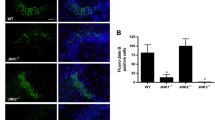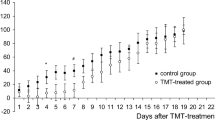Abstract
In the present study, we characterized the expression and role of forkhead box O (FoxO3a) in kainic acid (KA)-induced hippocampal neuronal cell death. FoxO3a and pFoxO3a expression in the CA1, CA2, and dentate gyrus regions in the hippocampus increased 0.5 and 1 h after intracerebroventricular administration of KA. In addition, both FoxO3a and pFoxO3a expression in the hippocampal CA3 region increased significantly and equally for 1 h but decreased gradually for 24 h after KA administration. In particular, the KA-induced increases in FoxO3a and pFoxO3a expression in the hippocampal CA3 region were inhibited by pretreatment with the N-methyl-d-aspartate (NMDA) receptor antagonist (MK-801, dizocilpine, 1 µg/5 µl) or a non-NMDA receptor antagonist (CNQX, 6-cyano-7-nitroquinoxaline-2,3-dione, 0.5 µg/5 µl). Furthermore, dizocilpine and CNQX produced a neuroprotective effect against KA-induced neuronal death in the CA3 region of the hippocampus. Our results suggest that FoxO3a and pFoxO3 expression is upregulated by KA. Both FoxO3a and pFoxO3a expression appear to be responsible for KA-induced neuronal death in the CA3 region of the hippocampus.



Similar content being viewed by others
References
Arzimanoglou A, Hirsch E, Nehlig A, Castelnau P, Gressens P, Pereira de Vasconcelos A (2002) Epilepsy and neuroprotection: an illustrated review. Epileptic Disord 4:173–182
Bakker WJ, Harris IS, Mak TW (2007) FOXO3a is activated in response to hypoxic stress and inhibits HIF1-induced apoptosis via regulation of CITED2. Mol Cell 28:941–953
Beal MF (1992) Mechanisms of excitotoxicity in neurologic diseases. FASEB J 6:3338–3344
Benveniste H, Drejer J, Schousboe A, Diemer NH (1984) Elevation of the extracellular concentrations of glutamate and aspartate in rat hippocampus during transient cerebral ischemia monitored by intracerebral microdialysis. J Neurochem 43:1369–1374
Bleakman D, Lodge D (1998) Neuropharmacology of AMPA and kainate receptors. Neuropharmacology 37:1187–1204
Brunet A, Bonni A, Zigmond MJ, Lin MZ, Juo P, Hu LS, Anderson MJ, Arden KC, Blenis J, Greenberg ME (1999) Akt promotes cell survival by phosphorylating and inhibiting a forkhead transcription factor. Cell 96:857–868
Candelario-Jalil E, Al-Dalain SM, Castillo R, Martinez G, Fernandez OS (2001) Selective vulnerability to kainate-induced oxidative damage in different rat brain regions. J Appl Toxicol 21:403–407
Chong ZZ, Li F, Maiese K (2005a) Activating Akt and the brain’s resources to drive cellular survival and prevent inflammatory injury. Histol Histopathol 20:299–315
Chong ZZ, Li F, Maiese K (2005b) Oxidative stress in the brain: novel cellular targets that govern survival during neurodegenerative disease. Prog Neurobiol 75:207–246
Chong ZZ, Li F, Maiese K (2006) Group I metabotropic receptor neuroprotection requires Akt and its substrates that govern FOXO3a, Bim, and beta-catenin during oxidative stress. Curr Neurovasc Res 3:107–117
Essers MA, Weijzen S, de Vries-Smits AM, Saarloos I, de Ruiter ND, Bos JL, Burgering BM (2004) FOXO transcription factor activation by oxidative stress mediated by the small GTPase Ral and JNK. EMBO J 23:4802–4812
Haley TJ, McCormick WG (1957) Pharmacological effects produced by intracerebral injection of drugs in the conscious mouse. Br J Pharmacol Chemother 12:12–15
Hoekman MF, Jacobs FM, Smidt MP, Burbach JP (2006) Spatial and temporal expression of FoxO transcription factors in the developing and adult murine brain. Gene Expr Patterns 6:134–140
Jacobs FM, van der Heide LP, Wijchers PJ, Burbach JP, Hoekman MF, Smidt MP (2003) FoxO6, a novel member of the FoxO class of transcription factors with distinct shuttling dynamics. J Biol Chem 278:35959–35967
Kaestner KH, Knochel W, Martinez DE (2000) Unified nomenclature for the winged helix/forkhead transcription factors. Genes Dev 14:142–146
Kaku DA, Goldberg MP, Choi DW (1991) Antagonism of non-NMDA receptors augments the neuroprotective effect of NMDA receptor blockade in cortical cultures subjected to prolonged deprivation of oxygen and glucose. Brain Res 554:344–347
Kim CH, Park SH, Sim YB, Sharma N, Kim SS, Lim SM, Jung JS, Suh HW (2014) Effect of pertussis and cholera toxins administered supraspinally on CA3 hippocampal neuronal cell death and the blood glucose level induced by kainic acid in mice. Neurosci Res 89:31–36
Lee JK, Choi SS, Lee HK, Han KJ, Han EJ, Suh HW (2002) Effects of MK-801 and CNQX on various neurotoxic responses induced by kainic acid in mice. Mol Cells 14:339–347
Lehtinen MK, Yuan Z, Boag PR, Yang Y, Villen J, Becker EB, DiBacco S, de la Iglesia N, Gygi S, Blackwell TK, Bonni A (2006) A conserved MST-FOXO signaling pathway mediates oxidative-stress responses and extends life span. Cell 125:987–1001
Leong ML, Maiyar AC, Kim B, O’Keeffe BA, Firestone GL (2003) Expression of the serum- and glucocorticoid-inducible protein kinase, Sgk, is a cell survival response to multiple types of environmental stress stimuli in mammary epithelial cells. J Biol Chem 278:5871–5882
Luo X, Puig O, Hyun J, Bohmann D, Jasper H (2007) Foxo and Fos regulate the decision between cell death and survival in response to UV irradiation. EMBO J 26:380–390
Maiese K, Hou J, Chong ZZ, Shang YC (2009) A fork in the path: developing therapeutic inroads with FoxO proteins. Oxid Med Cell Longev 2:119–129
Milatovic D, Gupta RC, Dettbarn WD (2002) Involvement of nitric oxide in kainic acid-induced excitotoxicity in rat brain. Brain Res 957:330–337
Perry G, Taddeo MA, Nunomura A, Zhu X, Zenteno-Savin T, Drew KL, Shimohama S, Avila J, Castellani RJ, Smith MA (2002) Comparative biology and pathology of oxidative stress in Alzheimer and other neurodegenerative diseases: beyond damage and response. Comp Biochem Physiol C 133:507–513
Rothman SM, Olney JW (1986) Glutamate and the pathophysiology of hypoxic–ischemic brain damage. Ann Neurol 19:105–111
Salih DA, Brunet A (2008) FoxO transcription factors in the maintenance of cellular homeostasis during aging. Curr Opin Cell Biol 20:126–136
Sapolsky RM (2003) Neuroprotective gene therapy against acute neurological insults. Nat Rev Neurosci 4:61–69
Shinoda S, Schindler CK, Meller R, So NK, Araki T, Yamamoto A, Lan JQ, Taki W, Simon RP, Henshall DC (2004) Bim regulation may determine hippocampal vulnerability after injurious seizures and in temporal lobe epilepsy. J Clin Invest 113:1059–1068
Simon RP, Griffiths T, Evans MC, Swan JH, Meldrum BS (1984) Calcium overload in selectively vulnerable neurons of the hippocampus during and after ischemia: an electron microscopy study in the rat. J Cereb Blood Flow Metab 4:350–361
Sperk G (1994) Kainic acid seizures in the rat. Prog Neurobiol 42:1–32
Sun AY, Cheng Y, Sun GY (1992) Kainic acid-induced excitotoxicity in neurons and glial cells. Prog Brain Res 94:271–280
van der Horst A, Burgering BM (2007) Stressing the role of FoxO proteins in lifespan and disease. Nat Rev Mol Cell Biol 8:440–450
Wang Q, Yu S, Simonyi A, Rottinghaus G, Sun GY, Sun AY (2004) Resveratrol protects against neurotoxicity induced by kainic acid. Neurochem Res 29:2105–2112
Wang MC, Bohmann D, Jasper H (2005) JNK extends life span and limits growth by antagonizing cellular and organism-wide responses to insulin signaling. Cell 121:115–125
Zagrean AM, Spataru A, Ceanga M, Zagrean L (2014) The single versus combinatorial effects of MK-801, CNQX, nifedipine and AP-3 on primary cultures of cerebellar granule cells in an oxygen-glucose deprivation model. Rom J Morphol Embryol 55:811–816
Acknowledgments
This research was supported by Priority Research Centers (NRF-2009-0094071 and NRF-2014R1A1A1006791) through the National Research Foundation of Korea (NRF) funded by the Ministry of Education, Science and Technology and Hallym University Specialization Fund (HRF-S-52).
Author information
Authors and Affiliations
Corresponding author
Ethics declarations
Conflict of interest
No potential conflicts of interest relevant to this article were reported.
Rights and permissions
About this article
Cite this article
Park, SH., Sim, YB., Lee, JK. et al. Characterization of temporal expressions of FOXO and pFOXO proteins in the hippocampus by kainic acid in mice: involvement of NMDA and non-NMDA receptors. Arch. Pharm. Res. 39, 660–667 (2016). https://doi.org/10.1007/s12272-016-0733-9
Received:
Accepted:
Published:
Issue Date:
DOI: https://doi.org/10.1007/s12272-016-0733-9




